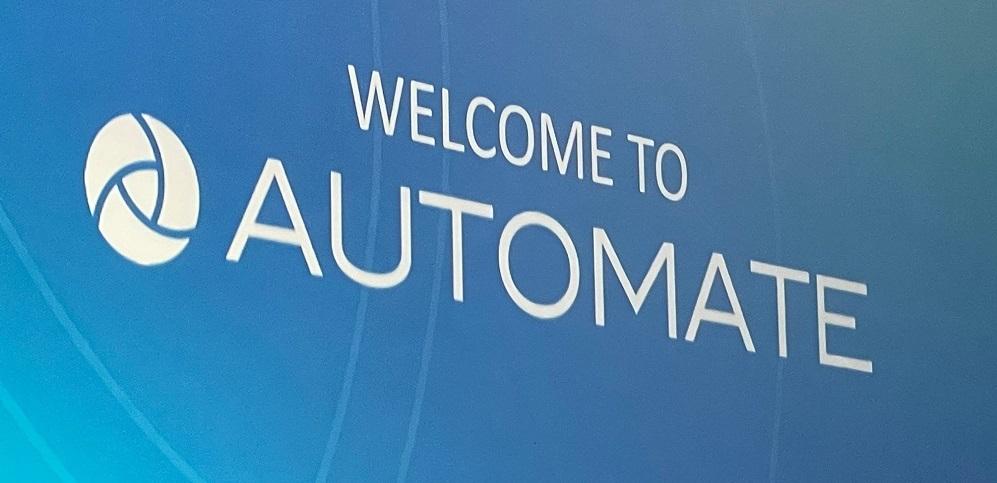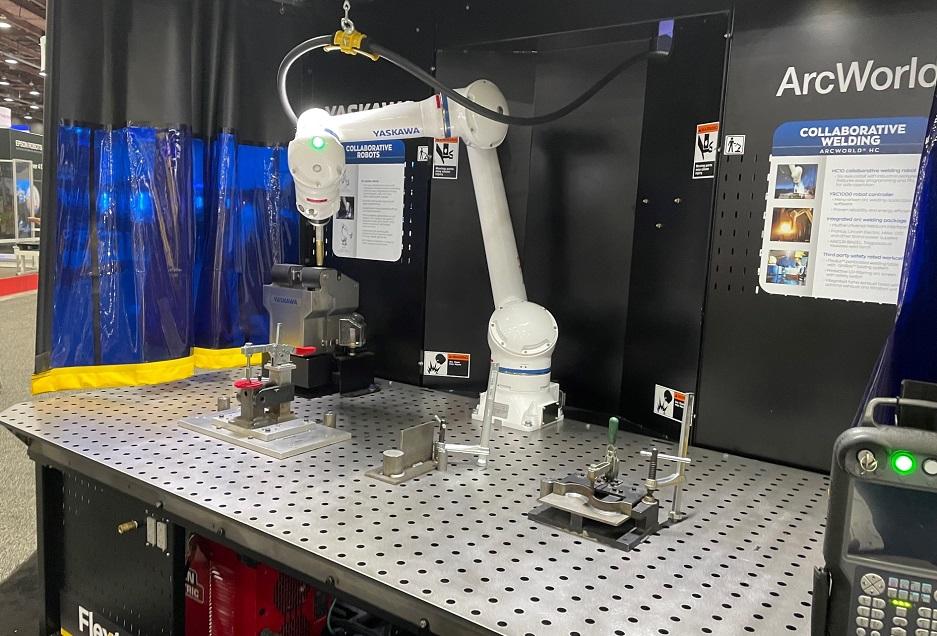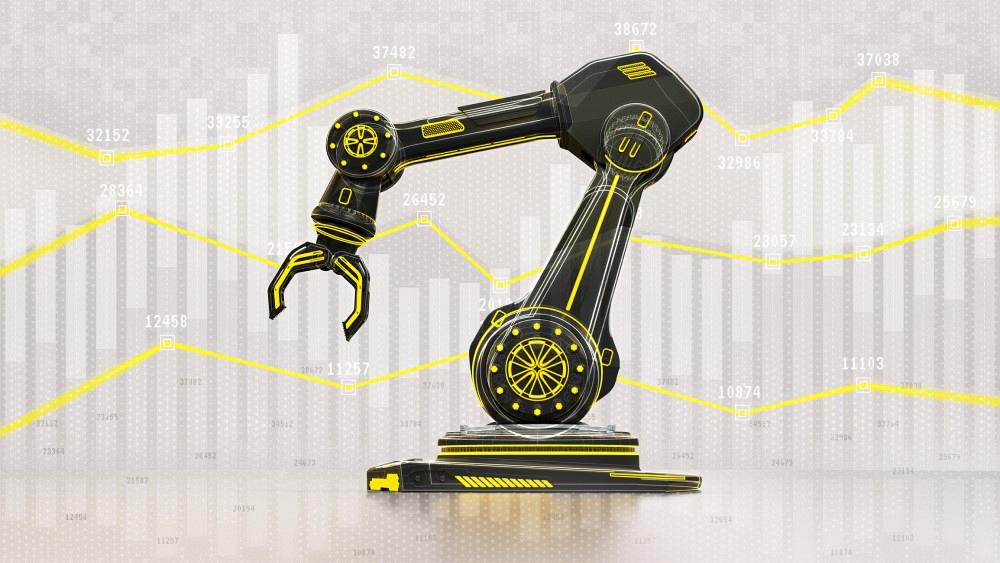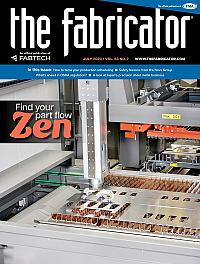Editor-in-Chief
- FMA
- The Fabricator
- FABTECH
- Canadian Metalworking
Categories
- Additive Manufacturing
- Aluminum Welding
- Arc Welding
- Assembly and Joining
- Automation and Robotics
- Bending and Forming
- Consumables
- Cutting and Weld Prep
- Electric Vehicles
- En Español
- Finishing
- Hydroforming
- Laser Cutting
- Laser Welding
- Machining
- Manufacturing Software
- Materials Handling
- Metals/Materials
- Oxyfuel Cutting
- Plasma Cutting
- Power Tools
- Punching and Other Holemaking
- Roll Forming
- Safety
- Sawing
- Shearing
- Shop Management
- Testing and Measuring
- Tube and Pipe Fabrication
- Tube and Pipe Production
- Waterjet Cutting
Industry Directory
Webcasts
Podcasts
FAB 40
Advertise
Subscribe
Account Login
Search
The rise of the collaborative robots on display at Automate 2023 in Detroit
A visit to the annual automation tradeshow reveals how hot the manufacturing market is for robotics
- By Dan Davis
- Updated July 24, 2023
- July 24, 2023
- Article
- Automation and Robotics
Greg Robinson, a 30-year NASA veteran, knows a thing or two about getting a project moving toward completion in the modern world.
He was pulled into the James Webb Space Telescope program as its director in 2018, where he oversaw a project that included more than 20,000 people and three space agencies. This was no run-of-the-mill mission for Robinson because the launch of the telescope had been delayed many times before he took over the project.
During his leadership, Robinson was able to get the many teams involved in the Webb Space Telescope program to start hitting program milestones, which ultimately made it possible to launch the next-generation telescope on Dec. 25, 2021, from the Guiana Space Centre in South America.
Robinson shared this story as the keynote speaker on the first day of Automate 2023 in Detroit on May 22. The launch of a telescope, which is twice the size of the Hubble Space Telescope yet half the mass, is something that everyone celebrates, particularly after looking at early images taken of nearby galaxies. But without the advancement of new technologies, Robinson said, the launch would never have taken place.
One of the most important advancements was the sun shield, which was instrumental in keeping the telescope extremely cold, allowing the infrared astronomy to be done. Robinson equated it to a sunscreen with a 1.2 million SPF rating. “That’s how good this sun shield is,” he said. An additional cryocooler, designed for this application, also helps to keep the telescope cool.
The use of microshutter technology allowed for the use of near-infrared spectroscopy and operates at such a pace that simultaneous observations of hundreds of individual objects in the near-infrared spectrograph can take place and the resulting image can be captured clearly.
In this case, the technological developments were needed for the Webb Space Telescope to be successful. Without them, space exploration would still be reliant on telescope technology from the early 1990s. Knowledge of the Earth’s history would be stagnated and open to questioning as the lack of new scientific evidence left room for conjecture.
Manufacturing in North America finds itself in a similar position. The inability to find labor interested in working in manufacturing-related jobs and the desire to ramp up manufacturing capacity to take advantage of new economic opportunities have led manufacturing companies to invest heavily in automation and robotics. That was clearly evident at the Automate show.
During his presentation, “The Start of a New Era: The Democratization of Industrial Automation,” where he discussed how his robotics integration company has grown because of its push to simplify the specification of and decrease the delivery time of robotic systems, Etienne Lacroix, co-founder and CEO of Vention vention.io, said that manufacturing companies have driven a lot of this growth in recent years. He estimated that of the almost 300,000 manufacturing businesses in North America, 91% had 99 or fewer employees. That leaves a lot of facilities with manual processes or semiautomated processes that need manual operator intervention as potential candidates for automation.
“We are seeing more companies employing advanced manufacturing teams for one or more facilities, and they are charged with implementing industrial automation,” Lacroix added.

Automate 2023, held in Detroit May 22-25, ended up being the largest event in the trade show’s history. It attracted more than 700 exhibitors and occupied 300,000 sq. ft. of exhibition space. This is dramatically larger than the days when the show was co-located with ProMat in the mid-2010s. With this renewed interest in automation technologies, show officials announced that Automate is moving to an every year schedule, moving to Chicago (May 6-9) in 2024 and then back to Detroit (May 12-15) in 2025.
The emergence of collaborative robots, which don’t require elaborate guarding because of their ability to work alongside humans without the threat of severely injuring them, and advances in their programming, have made them much more palatable for metal fabricators, who might have otherwise been scared off by the price tag and programming knowledge normally associated with traditional industrial robots. Additionally, these cobots can easily be deployed elsewhere for another function if a job ends or a piece of equipment is sold. Metal fabricators like the flexibility of them.
So it comes as no surprise that manufacturing applications have been driving a lot of the robot implementations in North America. In a presentation where representatives of FANUC, 3M, and Lincoln Electric talked about the possibilities associated with automating weld grinding, one of the speakers shared where annual robotic application growth is occurring:
- Coating and dispensing with 43% growth
- Arc welding at 15%
- Spot welding at 13%
- Material handling at 10%
- Assembly at 7%
- Other at 3%
Automate, a show that caters to many diverse industrial sectors, such as warehousing and food processing, had a healthy percentage of its 750 exhibitors showcasing manufacturing-related technologies. Here are some highlights.
Cobots Take On Spot Welding
Pro Spot Automation called its spot welding tool, built on a Universal Robots (UR) cobot platform, the first of its kind. While it seems like a very logical extension for the technology, Bob Hamilton, the company’s chief technology officer, said typical spot welding equipment was always too heavy for a cobot to carry and maneuver. But after two years of engineering effort, Pro Spot reconfigured the geometry of internal parts and incorporated new material in the spot welding unit’s design to lighten the load. The end result was showcased at Automate.
The new i5 Smart Spot Welder is integrated with the UR cobot controller, so the operator doesn’t need to worry about learning two separate control interfaces. Hamilton said that the unit actually contains an “auto weld” feature that takes the material being welded and the material thickness and delivers the correct weld power for the job, regardless of the thickness or the corrosion protection between the metals.
Because Pro Spot has its roots in the collision repair industry, the i5 provides detailed data logging, specifying such information as material thickness, power usage, and weld position, each time a spot weld is made. (This information is commonly required in collision repair, where shops have to demonstrate that they took steps to meet OEM collision repair requirements and insurance companies want to ensure the spot welds were done correctly.) Hamilton said that this data-logging capability might prove useful for any shop that has tracking responsibilities related to ISO or other certifications.
Making Automated Welding Easier
Yaskawa showcased its cobot-centric workcell, which it originally debuted at FABTECH 2022. The cell comes with a mobile Flextur fixture table, a Yaskawa HC cobot, a retractable arc curtain, a built-in exhaust hood, the metal fabricator’s choice of a welding supply, and a 14-ga. metal tool board.
“The target for this is the high-mix and low-volume manufacturing environment. If you are a contract manufacturer or a job shop, something like this makes sense for a job with just 50 pieces,” said Josh Leath, a Yaskawa senior product manager.
The weld cell is designed with the real-world shop in mind, according to Leath. It comes with a Yaskawa-branded torch that features reinforced aluminum tubing that provides rigidity should a crash occur. (The design also is used for cooling the torch while it’s in use.) The cell also has a torch tender, where the torch can be cleaned automatically after use, removing that maintenance task from the cell operator’s to-do list.
The cobot also can be used with the Wandelbots TracePen, which is a hand-held teaching device that assists a user in creating a welding path. The user takes the “pen,” traces the intended weld path, edits the path in the programming software, and begins the job. Wandelbots officials describe it as a “computer mouse” for cobot programming.

Pro Spot Automation redesigned its spot welding technology so that it could reside on the end of a cobot arm. The company suggests that this is the first spot welding tool designed to work on a cobot platform, in this case a UR robot.
Spartan Robotics has added MIG welding capability to the Kassow cobot platform. Kassow, which brought on Bosch Rexroth as a majority owner in 2022, manufactures cobots with seven axes of motion. The seven axes provide the cobot with the ability to be positioned in ways that other cobots with only six axes of motion can’t. For example, the robot arm can be placed in a way that allows it to reach into tight spaces or even around an obstacle in its way.
Pierre de Giorgio, president and chief technology officer, Spartan Robotics, said the added axis not only allows the welding arm to reach places that other cobot arms can’t, but it also helps the cobot avoid singularity, the condition where a robot might reach too far to the edge of its workspace, forcing the arm to slow down. The seventh axis helps to avoid a situation where the cobot wrist lies in the same plane as its elbow joints.
A cobot arm slowing down during a movement doesn’t sound like a big deal—unless it is welding, according to de Giorgio. Because smooth and consistent arm movement is needed to ensure a quality weld, the Kassow cobot makes a lot of sense for wire welding, de Giorgio said.
The Spartan 1 Welder uses a Fronius welding power source. The company also plans to develop a series of e-learning modules to help companies get the most out of the cobot welding system and stay on top of new technology developments related to the platform.
Finished With Manual Grinding?
John Spruce, founder and CEO of Kane Robotics, has developed GRIT robotics to assist manufacturers with a process that’s getting harder to fill: manual grinding. Spruce thinks that collaborative robots armed with quick-change tooling can eliminate this human resource, challenging for high-mix, low-volume manufacturers.
Spruce, who came from the aerospace and defense manufacturing industry, said adapting cobots for these tedious sanding, grinding, and finishing jobs makes sense because people really don’t want to do the job for entire shifts. “It’s dull, dirty, dangerous, and debilitating,” he said, emphasizing the latter because extended handling of a power tool can certainly lead to injuries like carpal tunnel syndrome, which no small or medium-sized company wants to address.
Kane Robotics displayed its GRIT XL cell that had a UR cobot attached from an overhead beam, providing it with access to both sides of a mobile table. Armed with a buffing tool, the cobot simulated the polishing of a car hood.
Spruce said one of the first applications for the cobot finishing system was the sanding of a rocket wall made of composite material. The cobot was a good choice for the job because the exterior surface had to be “prepped” for the attachment of other components, but the composite material couldn’t be altered in any major way without sacrificing the integrity of the rocket body.
The GRIT system has not been limited to aerospace applications, however. Spruce said a maker of oil and gas components for drill sites uses the cell for removing weld beads.
“What if that part goes away? You just reconfigure the cobot,” Spruce said. “As an investment, it’s low risk.”

The ArcWorld HC is Yaskawa’s answer for the metal fabricating shop that wants a turnkey cobot-focused welding cell. It sits atop a Flextur modular welding table and can be moved to where it’s needed in a shop.
Multicell Attendant
Automated material movement is growing more commonplace in large warehouses and manufacturing settings, but you don’t see it often in small and medium-sized companies. That could be changing, however.
Waybo, a designer and manufacturer of robotic cells, and KUKA Robotics demonstrated a machine tending cell in the KUKA Robotics booth. A KUKA LBR iisy cobot was attached to a KUKA KMP 1500 industrial mobile robot cruising among a mock-up of a CNC mill, an inspection station, and an engraving device. The cobot grabbed the parts from the CNC, restocked the CNC, and repeated the same tasks for the subsequent stops.
Jean-Sébastien Neveu, Waybo’s president, said the real challenge of creating this type of multicell robotic attendant was settling on a common “pallet,” the fixture on which the workpiece sits. With that consistent for all the stations in a cell, software programmers didn’t have to worry about hundreds of special workholding situations. The cobot on top of the industrial mobile robot can have one end effector to load and unload a variety of workpieces.
RFID readers on the end effector tooling scan a chip in the pallets, which associates the pallet with a job. From that information exchange, the cobot knows how to approach the part.
Neveu added that this type of cell is designed to be easily set up should a current cell no longer be needed. It can be used with any number of different CNCs and used for other functions beyond loading and unloading. The cobot can be used for marking, inspection, and washing, for example.
“Everything is scalable,” he said.
About the Author

Dan Davis
2135 Point Blvd.
Elgin, IL 60123
815-227-8281
Dan Davis is editor-in-chief of The Fabricator, the industry's most widely circulated metal fabricating magazine, and its sister publications, The Tube & Pipe Journal and The Welder. He has been with the publications since April 2002.
subscribe now

The Fabricator is North America's leading magazine for the metal forming and fabricating industry. The magazine delivers the news, technical articles, and case histories that enable fabricators to do their jobs more efficiently. The Fabricator has served the industry since 1970.
start your free subscription- Stay connected from anywhere

Easily access valuable industry resources now with full access to the digital edition of The Fabricator.

Easily access valuable industry resources now with full access to the digital edition of The Welder.

Easily access valuable industry resources now with full access to the digital edition of The Tube and Pipe Journal.
- Podcasting
- Podcast:
- The Fabricator Podcast
- Published:
- 04/16/2024
- Running Time:
- 63:29
In this episode of The Fabricator Podcast, Caleb Chamberlain, co-founder and CEO of OSH Cut, discusses his company’s...
- Trending Articles
Tips for creating sheet metal tubes with perforations

Are two heads better than one in fiber laser cutting?

Supporting the metal fabricating industry through FMA

JM Steel triples capacity for solar energy projects at Pennsylvania facility

Omco Solar opens second Alabama manufacturing facility

- Industry Events
16th Annual Safety Conference
- April 30 - May 1, 2024
- Elgin,
Pipe and Tube Conference
- May 21 - 22, 2024
- Omaha, NE
World-Class Roll Forming Workshop
- June 5 - 6, 2024
- Louisville, KY
Advanced Laser Application Workshop
- June 25 - 27, 2024
- Novi, MI




























